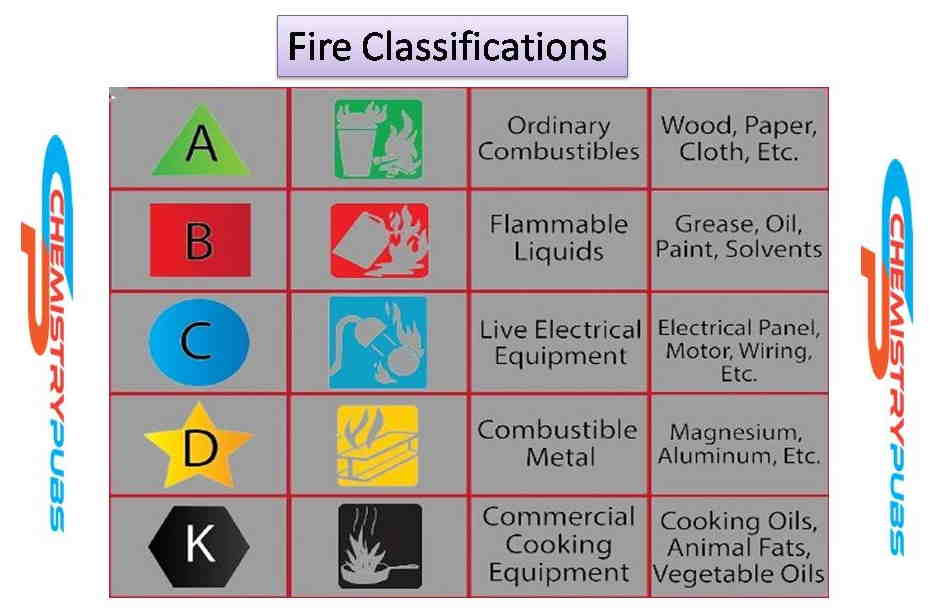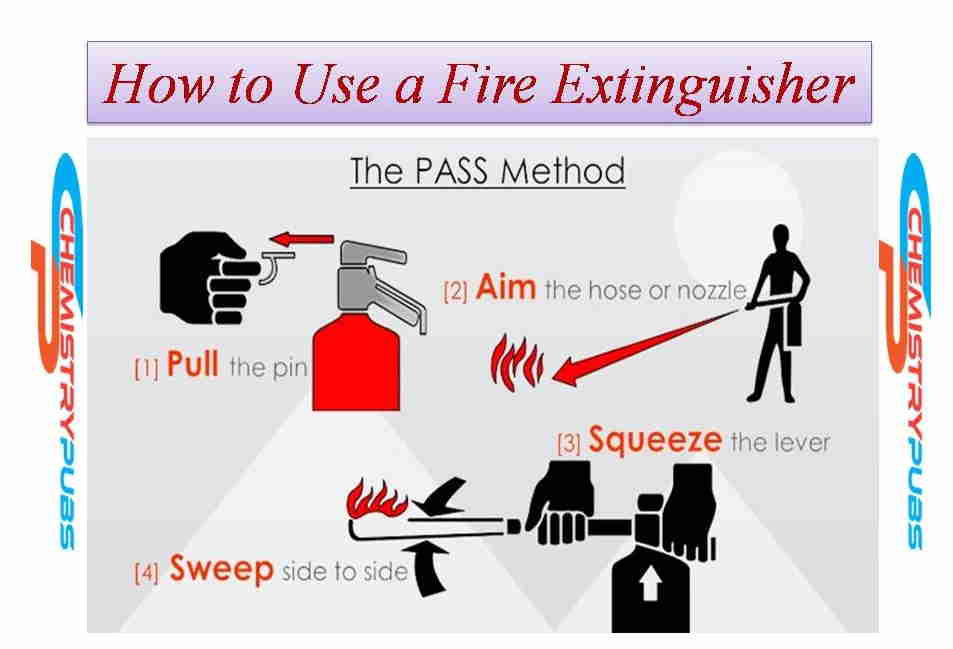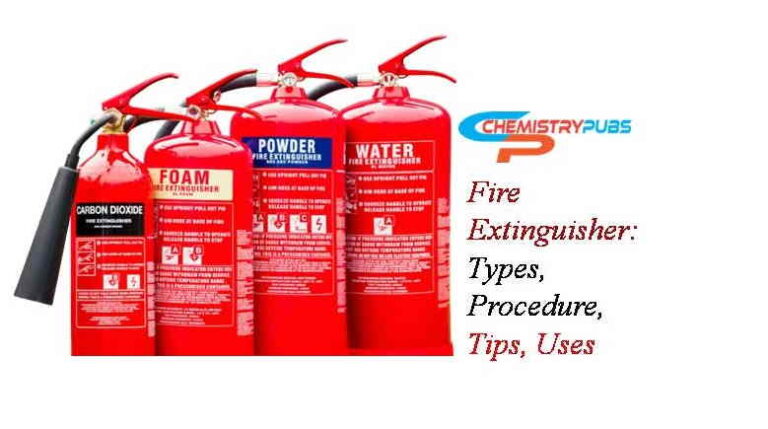A fire extinguisher is an essential stationary or portable device filled with chemicals and used to control or extinguish small fires. This device is kept near position in industries, buildings, factories, transportation areas, and public places. The numbers and types of the extinguisher depend on the characteristics of the particular area.
This device contains a liquid, gas, or chemical agent and a propellant for controlling or extinguishing a small fire. This can be done by discharging and directing the liquid, gas, or chemical agent at the seat of a small fire.
This device is designed in such a way that it can be transported easily by anybody from its storage location to a small fire and operated manually by hand. This device has a gross mass of weight and not more than 23 kg.
Types of Fire
Class A type fire
This class involves various combustible materials like cloth, rubber, wood, paper, and many plastics. A fire extinguisher with an A rating is designed in such a way that it can control or extinguish a fire involving these ordinary combustible materials.

Class B-type fire
This class involves flammable and combustible liquids like gasoline, oil-based paints, alcohol, and lacquers. A fire extinguisher with a B rating is designed in such a way that it can control or extinguish fire involving flammable and combustible liquids.
Class C-type fire
This class involves energized electrical equipment. A fire extinguisher with a C rating is designed in such a way that it can control or extinguish a fire involving energized electrical equipment.
Class D-type fire
This class involves combustible metals, such as magnesium, titanium, and sodium. A fire extinguisher with a D rating is designed in such a way that it can control or extinguish fire involving combustible metals.
Class K-type fire
This class involves vegetable oils, animal oils, or fats in cooking appliances. A fire extinguisher with a K rating is designed in such a way that it can control or extinguish fires involving vegetable oils, animal oils, or fats utilized in various cooking appliances.
Multipurpose Fire Extinguisher
At present, this type of fire extinguisher is used for more than one classification of fire. For example, a BC-rating fire extinguisher is used for controlling fire created by flammable liquids and energized electrical equipment. ABC rating fire extinguisher is suitable for controlling fire created by ordinary combustibles, flammable liquids, and energized electrical equipment.
An extinguisher with an ABC rating is suitable for use with fires involving ordinary combustibles, flammable liquids, and energized electrical equipment. An extinguisher that is rated for use with multiple hazards should include a symbol for each hazard type.
How to Use a Fire Extinguisher (Operating Procedure)?
There exist four general steps to operate this device. The general operating procedure of the extinguisher can be remembered by the word “PASS.” This device operates to control or extinguish Class A, B, and C fires.
Pull the pin: Firstly, it should take the device with the nozzle pointing and release the locking property. It means pulling out the pin from the device located below the trigger.
Aim low: Secondly, it should stand 7 to 8 feet away from the human body from the point of fire and point the nozzle at the base of the fire to control the fire’s existence. It must be remembered that the extinguisher should be held vertically and operated in an upright position. It must avoid using it horizontally or at an angle in your arms.

Squeeze the trigger: Thirdly, it must squeeze the trigger of the extinguisher slowly which releases the extinguishing agent and expels it through the nozzle.
Sweep side to side: Finally, it should sweep the extinguisher again and again in an upright position until the fire is extinguished.
Tips to Use of a Fire Extinguisher
It should be kept in the nearest position of working areas.
It should confirm the location of the fire extinguisher which is an operable condition.
It should know how to use this extinguisher during the fire breaking out.
It should evacuate the building by starting the fire alarm before using this device at the fire point.
This device should be used to control a small amount of fire.
It must be positioned by anybody between the exit and the fire locations.
It must be replaced or serviced after using an extinguisher.
Types of Fire Extinguisher
Water Type
It is considered as the primary liquid substance to control the fire. It should not be kept in a refrigerator because it can be cold and render the extinguisher unusable. At present, there are many fire extinguishers containing antifreeze which will help the water-type extinguisher to be used in freezing conditions.
It can be used some wetting agents into this extinguisher to increase the effectiveness against fire. This type of extinguisher is very suitable for use on Class A fires.
Film-forming foam type
In this type fire extinguisher is prepared by AFFF (aqueous film-forming foam) and FFFP (film-forming fluoroprotein) to control both Class A and Class B fires. This class of extinguisher discharges foam material rather than liquid or powder to control the fire. It should be avoided to keep it a lower temperature condition.
Carbon Dioxide type
This type of fire extinguisher is used to control Class B and Class C fires. It releases carbon dioxide in the form of a gas or snow cloud. It should be used in the range of 4 ft to 8 ft (1.3 m to 2.4 m). This type of extinguisher is not perfect to use where windy conditions prevail or for indoor use where strong air currents are available.
Halogenated agent types
Halon
Halon 1211 or Bromochlorodifluoromethane fire extinguisher is used to extinguish the fire creation. It can be used in cold weather conditions and leaves no residue. It damages the ozone layer and is listed to control the Class A as well as Class B and Class C fires.
Halon Alternative Clean Agents
There exist various cleaning agents that are noncorrosive, and nonconductive, and evaporate after use, leaving no residue. They have the ability to control the Class A as well as Class B and Class C fires. This type of fire extinguisher does not create any detrimental effect on the earth’s ozone layer. So this type of extinguisher is more popular than the Halon type extinguisher.
Dry chemical types
Ordinary Dry Chemical: This type of extinguisher consists of dry chemical powder composed of very small particulates. There are various chemicals used such as sodium bicarbonate base and potassium bicarbonate base.
Multipurpose Dry Chemical
This type of fire extinguisher contains an ammonium phosphate base agent which is very suitable for controlling class A and class type fire.
Wet chemical type
This type of fire extinguisher is comprised of solutions of water and potassium acetate, potassium citrate, potassium carbonate, or a combination of these chemicals. These liquids provide a pH of 9.0 or less. This type of extinguisher acts as a coolant on class A fire and creates a foam blanket to prevent re-ignition.
Dry powder type
This type of fire extinguisher is used to control Class D fires and specific metals by following the special techniques and manufacturer’s recommendations for use.
Maintenance of Fire extinguisher
The maintenance of the extinguisher is very important to get perfect results from it. It should be checked after 6 months or yearly to service or replacement. The standard-specific criteria should be maintained which is provided with it.
Frequently Asked Questions (FAQ’s)
What is a fire extinguisher?
It is urgent needed portable devices filled with chemicals and used to control or extinguish small fires.
What is a fire triangle?
It is a triangle related to the starting of a fire which consists of fuel, air, and a heating source. Fuel is essential for combustion purposes and the heating source provides ignition temperature. Air is considered the main oxygen supply source for letting the fire burn.
What are the different colors to identify various types of fire extinguishers?
The bright red color fire extinguisher is water type and the cream type extinguisher relates to the foam type fire extinguisher. Dry powder type fire extinguisher contains blue color and wet chemical type extinguisher contains yellow color. Carbon dioxide type extinguisher contains black label color on its surface area.
What are the different types of fire extinguishers?
There exists water type, foam type, dry powder type, wet chemical type, and carbon dioxide-type fire extinguishers in the market.
What are the ABCD classes of fire?
The fire which is created by solid materials includes class A fire. The fire which is created by liquids or gas includes class B fire. The fire is created by electronic equipment including class C fire. The fire which is created by metallic substances includes class D fire.
What is the use fire extinguisher?
It is used to control or prevent fire existence in working places or household conditions in a small area.
What is an ABCD fire extinguisher? The extinguisher is used to control or remove fire created by solid materials, liquid or gaseous elements, electrical

